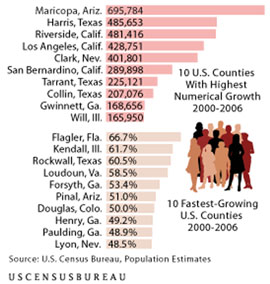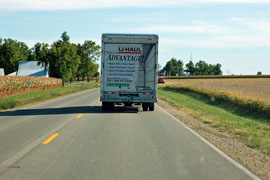Cronkite News has moved to a new home at cronkitenews.azpbs.org. Use this site to search archives from 2011 to May 2015. You can search the new site for current stories.
Maricopa residents came from far and wide, left for farther and wider
WASHINGTON – Maricopa County led the nation in the number of counties its new residents came from and the number of counties its former residents moved to, the U.S. Census Bureau reported Wednesday.
The bureau said that in a given year between 2005 and 2010, people came to Maricopa from 993 counties across the country and county residents moved out to 1,156 counties, both tops in the nation.
Demographers were not surprised by the numbers. For several years, Maricopa led the nation in population growth and experts said a sour economy in recent years could have sent those people back to their previous hometowns.
“With the economic recession, we saw a lot of different kinds of migration,” said Jennifer Glick, a social demographer at Arizona State University. “People who couldn’t find jobs here, or lost jobs here, where do they go? They often go back to where they’re from.”
Over the last decade, Maricopa attracted new residents for a wide range of reasons, from jobs to retirement communities, so it makes sense the county experienced significant turnover, Glick said.
“Because of the rapid growth of Phoenix, because we drew so many people – it makes sense that we would be dispersing,” she said.
Even though Maricopa had the widest dispersion of residents, it did not see the highest numbers of people moving: Los Angeles County had the most people coming and going in an average year, the report said.
One reason Maricopa residents ranged farther and wider could be that the counties surrounding Los Angeles are significantly larger, said Jim Chang, state demographer for the Arizona Office of Employment and Population Statistics.
“Even though Los Angeles was sending people to fewer counties than Maricopa, the receiving counties are much larger,” Chang said. “Los Angeles is a much, much bigger metro area. Maricopa County doesn’t have those neighbors.”
Most of the movement to or from Maricopa County was between it and Arizona’s Pinal, Pima and Coconino counties and California’s Los Angeles and San Diego counties.
The lead statistician for the Census report agreed that the size of adjacent counties could have been a factor in how far residents traveled when making a move.
“A lot of Los Angeles is neighboring large counties,” said Kin Koerber, a Census Bureau statistician. “They are all counties with over a million people or at least two million, so a lot of the Los Angeles movement is in the Southern California location.”
The most frequent county-to-county moves across the nation occurred between Los Angeles and San Bernardino, Calif.; Los Angeles and Orange, Calif.; and Los Angeles and Riverside, Calif., the report said.
Koerber noted that Maricopa was the nation’s fourth-largest county in 2009, according to Census estimates, which could have contributed to the wide scattering of its residents. But he could not say for sure what actually caused Maricopa’s No. 1 standing.
“It’s not a perfect correlation, but there is some correlation,” to overall population, Koerber said. “The large counties do tend to have more potential movers and enlist more dispersion, but I don’t know exactly why there were more for Maricopa than Los Angeles.”
Regardless of the trends described in the report, Chang cautioned that the numbers are still estimates based on Census surveys and not on the official 2010 census. And, he noted, they reflect population shifts from as long as seven years ago.
“Don’t jump to the conclusion that Maricopa County, or any county, is still doing what this data shows,” he said. “The situation has changed a lot.
“As we have fewer numbers of migrants, the dispersement is probably not as much,” Chang said. “We are pretty confident that we are not having as many immigrants as we did five, six years ago.”








